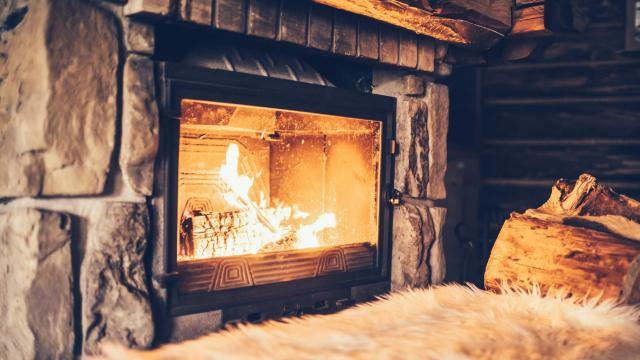It’s fireplace season in many areas right now, which (hopefully) means cosy evenings spent curled up in front of its warm glow. Or, maybe you were cleaning and came across a bunch of letters and gifts from an ex, and felt that warm glow beckoning to you for other, less cosy reasons.
If you have a real, wood-burning fireplace, you do need to feed it — but as it turns out, you can’t just pop in anything made of wood (or other materials, for that matter) and call it a day. In fact, according to an article in the Farmer’s Almanac by Carol J. Alexander, there’s a whole list of woods and other items that should never find their way into a fireplace. Here’s what to keep away from those flames.
Wet, damp, or unseasoned wood
In some cases, even what appears to be firewood shouldn’t go in the fireplace. That’s because, as Alexander explains, firewood needs to be properly seasoned — meaning it contains little-to-no moisture.
And it’s not a matter of bringing them in overnight: The seasoning process takes at least a year. “You can recognise seasoned wood by its appearance — properly dried wood is grey in colour, cracked or checked, with loose or detached bark,” she writes.
Even if firewood is properly seasoned, it can’t go in the fireplace when it’s wet or damp, so be sure to store yours somewhere that’s shielded from the elements.
Treated, painted, or manufactured wood
When you burn a piece of wood, you’re also burning everything on it — including the chemicals used to treat or paint the wood, or adhesives keeping manufactured wood like particle board together. As Alexander points out, you don’t want to inhale the byproducts of burning chemicals. For this reason, you should also avoid burning wood pallets, as she says they are often treated with chemicals.
Christmas trees (and other resinous wood)
Know that sticky stuff that’s on live Christmas trees? It’s called resin (or sap), and trees that contain the substance — like pine, spruce, and cedar — shouldn’t go in the fireplace either, Alexander says. If you burn too much resinous wood, it can increase the amount of creosote in your chimney (meaning you’ll need to clean it more often). Plus, resin makes the fire pop, which can cause stray embers to travel outside the confines of your fireplace and burn someone nearby.
Printed, coloured, or coated paper products
Using plain old black and white newspaper to get a fire started is fine, Alexander says, but paper products that have any sort of printing, colouring, or coating on them shouldn’t go in the fireplace. Even if they’re printed using soy ink, the papers likely have pigments and other additives, as well. And according to Alexander, the coating used to make gift wrap and direct-mail flyers thicker doesn’t burn clean, either.
Plastics
No one should have to tell you never to burn anything made of plastic in your fireplace, but we’ll leave this here, just in case.

Leave a Reply
You must be logged in to post a comment.